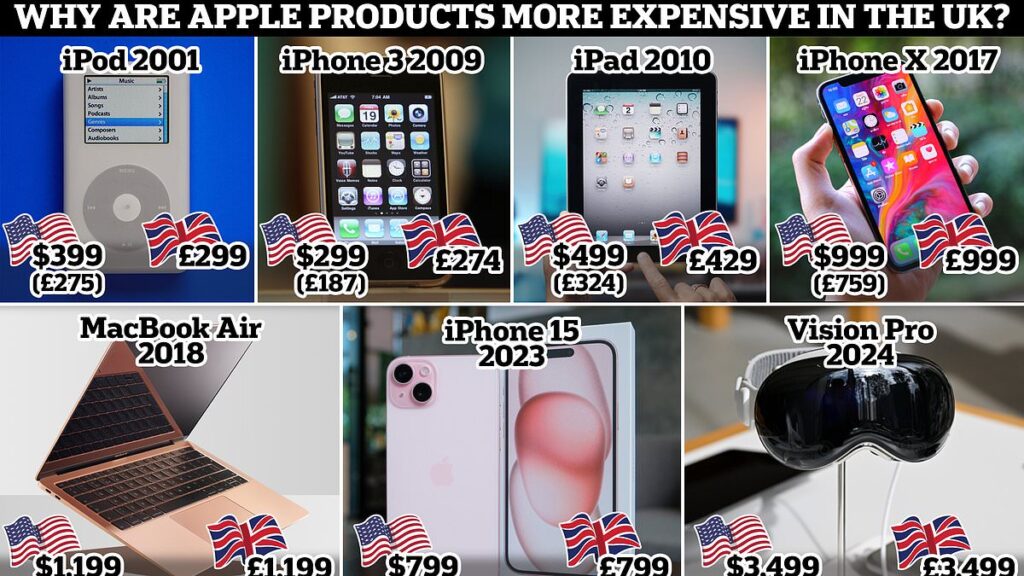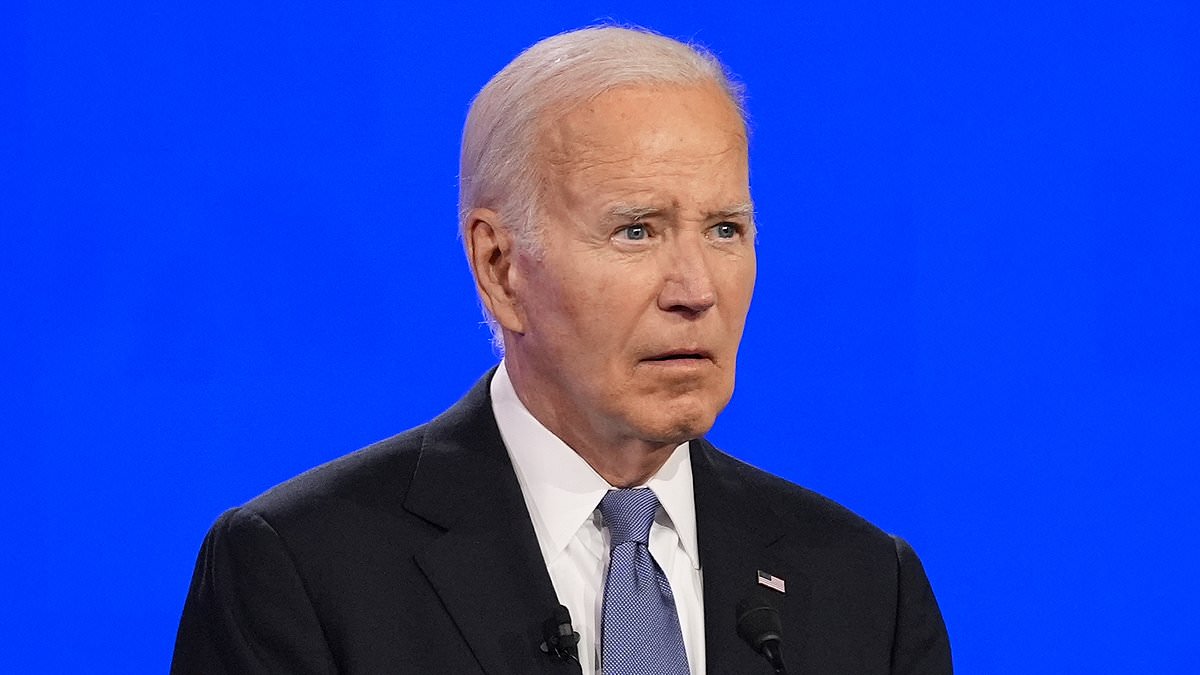The Vision Pro headset has is finally available to buy in the UK, but Brits aren’t happy to pay even more on Apple’s hottest new gadget.
Since February, Vision Pro – the headset that lets wearers select apps with their eyes – has been available in the US at the cost of $3,499 (£2,759).
But the UK price is around £700 higher – a whopping £3,499 ($4,434) – and Brits have taken to X (Twitter) to complain.
One pointed out that it would be cheaper to fly to New York to pick up a Vision Pro and return home to London.
It reflects a general trend with Apple over the last few years, with iPhones, iPads and MacBooks among the products that have cost more across the Atlantic.

iPhones, iPads and Macs are among the Apple products that have cost more in the UK in recent years – but why is this?

Apple’s Vision Pro is now available to pre-order in the UK, as well as Canada, Germany, France, Australia, but it won’t start shipping or appear in Apple Stores until July 12
What is the Vision Pro?
Vision Pro is Apple’s head-mounted wearable that ‘blends digital content with a physical space’.
It lets wearers choose apps with their eyes or watch sports on a massive virtual screen.
It offers ‘mixed reality’ – so a combination of virtual reality (VR) and augmented reality (AR).
But it doesn’t come cheap – it retails for $3,499 (£2,759) in the US and £3,499 ($4,434) in the UK.
Before the UK release, fans have already been bringing the device back from the US – ultimately saving money than if they waited and purchased it in the UK.
George Jijiashvili, senior principal analyst at Omdia, said UK prices on Apple products are higher due to value-added tax (VAT) implemented by the UK government.
‘There doesn’t appear to be an obvious pattern for why the US-UK price differential varies so much, but, it’s better for some devices than others,’ Jijiashvili said.
The expert also thinks Apple has a ‘pricing strategy’, although details about what informs that strategy may be closely-guarded.
Especially in recent years, Apple has tended to charge the same amount of US dollars and UK pounds for a product – for example $799/£799 for the iPhone 15.
For those who are unfamiliar with exchange rates, this may make the product seem like it’s around about the same price in the two territories.
Paolo Pescatore, analyst at PP Foresight, said Vision Pro’s ‘eye-watering’ price in the UK will ‘certainly raise eyebrows’.
‘It is a premium device that is produced with premium materials that more than likely will cost a bit more,’ Pescatore said.
‘This is due to a combination of factors including the exchange rate and local taxes as well as the bill of materials (BOM) – essentially the parts that make up the device.’

Brits have taken to X (Twitter) to complain, with one pointing out that it would be cheaper to fly to New York to pick one up

Before the UK release, fans have already been bringing the device back from the US – ultimately saving money than if they waited and purchased in the UK
Apple’s Vision Pro is now available to pre-order in the UK, as well as Canada, Germany, France, Australia, although it won’t start shipping or appear in Apple Stores in these countries until July 12.
It’s been described as the company’s first virtual reality (VR) headset, although it actually combines elements of both VR and augmented reality (AR) – where digital images are overlaid on real-life surroundings.
The 600g Vision Pro has a single, thick band on the back of the head, connecting a large, sleek screen that sits over the eyes.
While wearing the headset, users select content inside the goggles with their eyes, tap their fingers together to click, and gently flick to scroll.
With the device, users can choose apps just by looking at them, play immersive games or watch sports and films on a massive virtual screen.
It is powered by an external rechargeable battery that you can use for up to two hours of general use, or all day when plugged into the wall.

A customer learns to use the Vision Pro at the launch in Singapore on Friday. The device launched in Asian nations last week

Vision Pro is the first Apple product ‘you look out of and not at,’ CEO Tim Cook said when the company revealed it last year. Pictured, Apple Store in Beijing on June 28, 2024
Apple CEO Tim Cook said during its unveiling that it’s the first Apple product ‘you look out of and not at’, heralding a new era of ‘spatial computing’.
But reviews have criticized the device for draining power quickly and being too heavy to wear, as well as its ‘absurd’ price tag.
Aside from receiving perplexed glances from onlookers, users have also complained of headaches, eye strain and even burst blood vessels.
In its review, MailOnline found the virtual visuals to be ‘genuinely mesmerizing’ but decided it wasn’t worth five times the price of rival Meta’s Oculus headset.
MailOnline has contacted Apple for comment.
What do experts make of Apple’s $3,500 Vision Pro headset?
Following months of rumours, Apple unveiled its ‘Vision Pro’ augmented reality headset at the first day of Worldwide Developers Conference (WWDC) 2023.
The headset lets users merge the real world with a digital one navigated by their eyes, voice and hands – with no controllers needed.
Analysts appeared skeptical about Apple’s reasons for creating the device, although many seemed impressed with aspects of the technology.
Leo Gebbie, principal analyst of connected devices at CCS Insight, said: ‘The Vision Pro headset is Apple’s boldest new product in years, with some people suggesting this is Tim Cook’s very own ‘iPhone moment’.
‘It sees the company enter a brand new market, where other companies have struggled to transform futuristic concepts into reality, and offer an exciting and innovative product.
‘Apple has already claimed that the Vision Pro is ‘the most advanced personal electronics device ever’ and will now have to work hard to back up the statement.
‘The Vision Pro has a luxurious build, as would be expected with its premium price tag, and its 3D-formed laminated glass and aluminium chassis is certainly eye-catching.
‘We predict that Apple’s entry into the spatial computing market will lift the fortunes of all players, but the Vision Pro is some way away from being a mass market offering given its price tag.’
Paolo Pescatore, analyst at PP Foresight, said: ‘Make no mistake, this is a wow moment for the company and the consumer electronics industry.
‘It marks Apple’s biggest device launch in a while (since the Apple Watch) that will change the way we interact and engage with content forever.
‘Apple has grand plans to revolutionise this segment as it has done with the iPhone; remember this is its first foray.
‘The hardware, services and experiences will evolve considerably over time to include other devices.’
Dominik Angerer, co-founder and CEO of software company Storyblok, said: ‘The data shows businesses believe VR/AR is the future of content, but after so many false starts in recent years, marketers are clearly more sceptical about the potential of the technology.
‘The good news for Apple is that developers are very enthusiastic about building for the platform, even though they don’t know anything about it.
‘The level of support from developers will ultimately make or break the product










